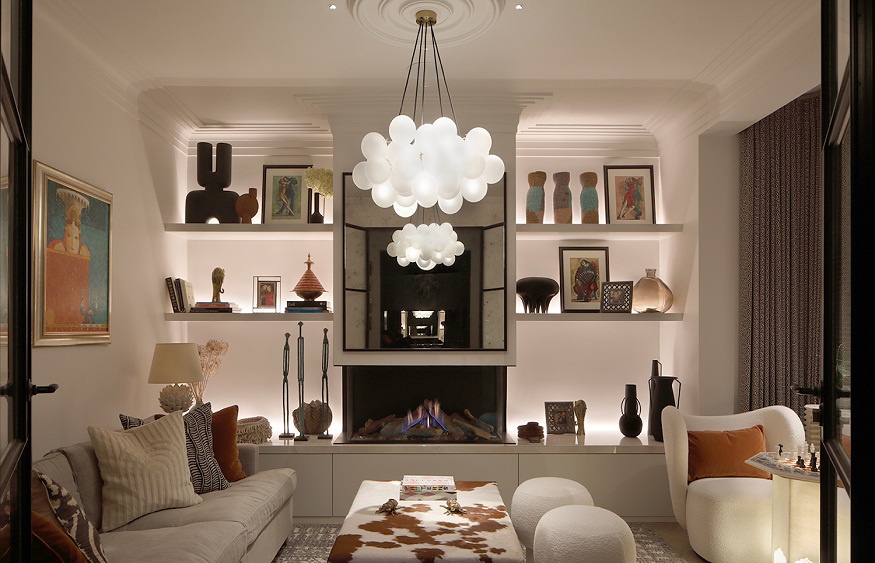If you believe that the main focus of interior design is furniture, colour or layout, you are wrong. Because the main focus of interior design is and must be lighting. Lighting is not just about the brightness, but also setting the mood. And in case you didn’t know, as an interior design company, we understand that choosing the right lighting can create a cosy environment, boost your moods and even impact your mental health. But how?
In this blog, we will discuss the basics and types of interior lighting and its impact on mental health.
The importance of lighting in interior design
Like every other element, lighting is also important in design. Good lighting has the power to transform the space. Light can be used to make the space feel comfortable, dramatic and also atmospheric. Depending upon the choice of the customer and their demand, lighting can have a severe impact on their space. Have you seen artworks being downlit with a darker area around them? This is done to capture one’s complete attention to the art, making it the masterpiece in the area!
Different types of lighting in interior design
There are four main types of lighting in interior design. Incorporating all four and different lighting is essential to make the interior well-balanced and inviting. As you may have heard, the four types of lighting are ambient, task, accent and decorative lighting and each type serves a distinct purpose. And when layered together, these can transform the space into a beautiful and visually appealing environment.
- Ambient lighting: it provides complete and overall illumination. This ensures that the space is lit, uniformly. The brightness it creates is comfortable, without any glare and allows people to move around safely and perform their tasks.
- Task lighting: it provides focused and bright lighting. Designed for specific activities such as reading, cooking, working, etc, these are usually made practical through desk lamps, under-cabinet lights and pendant lights.
- Decorative lighting: the role of decorative lighting is to contribute to the overall aesthetic of the space. It is implemented through chandeliers, wall scones and other artistic elements.
- Accent lighting: this is used to highlight a special and particular feature in the space like artwork, plants, etc. The purpose of such lighting is to add depth and dimension by creating focal points to catch your attention.
What is the impact of artificial lighting and daylight on interior design?
Artificial lighting:
- It creates visual stimulation. Artificial lighting is used to accentuate specific features so that we are always drawn to the brightest point in a room.
- Such lighting also brings focus to the room’s edges to broaden the perspective. Subtle light can also be added to vertical spaces to create a reflected light off those surfaces.
- Through well-designed artificial lighting, brightness, depth and drama can be added to the space.
Daylight:
Daylight is a crucial factor in interior design. Designers monitor how daylight enters each space and corner of the room and everything is placed based on this. Consider a living space with expansive gazing, here daylight will pour in and will make it bright and open.
Also, in lighting, architectural lights play a prominent role when there is daylight. It is used to brighten dark spots in shelving and to add highlights to task areas and artwork. The key solution to managing the various lighting options is to use a combination of daylight and artificial lighting. There are many pre-set options of the same, available in the market, making it easier for you to choose.
Decorative lighting in interior design
Decorative speaks dramatically. Consider adding decorative lighting like a dramatic pendant or an interesting wall light- this adds more drama to your room. Even though our eyes may be drawn to the most magnificent space in the room, adding decorative lighting will add to its quality. Hence, combining decorative lighting with architectural lights will provide the best results.
What is architectural lighting in interior design?
Architectural lighting is a combination of concealed lighting placed within the architectural figures. Some sources of lighting include downlights, unplights, LED strip lights etc. These contribute to creating an interesting space. And they gel quickly with the architecture. This provides illumination by emphasising materials.
Lighting and mental health
In case you didn’t know, proper lighting has a major role to play in your lighting. Studies have shown that short and long-term moods can be improved through accessing natural light as the colour and type of light can make a huge difference in the way you feel.
- It makes us feel more alert, relaxed and also creative. Hence, the type of lighting, its colour and brightness can determine the way you feel. If you are looking for the best source of light to brighten up your mood, then natural light is the best. The thing about natural light is that it is bright but not too bright to cause a headache and has a cool, natural and earthy colour which stimulates the brain.
- Studies have shown that natural light helps in regulating your body’s circadian rhythm, which is the body’s natural sleep and wake cycle. When there is ample access to natural light, you are more likely to be bright and awake during the day. This doesn’t mean that only natural light can bring you peace. Even if you have limited access to natural lighting, there are ways through which you can manage your mood. Ultimately the goal is to make sure that the lighting doesn’t create a negative impact on you.
- Unlike natural light, artificial lighting can also have a positive impact on you and your mood. All you must do is to choose the right type and this is why you can always seek professional advice from interior designers.
- Too much lighting can make you feel stressed and weak lighting can make you feel tired. Based on what you are trying to do and accomplish, the idea of brightness will vary.
- When it comes to colours, bright colours can be energizing while soft colours can be comforting and calming. Suppose you have installed a dimmer (not weak) light in your space, this can make your space more cozy and inviting while installing a cool blue light can make it more spacious and airier.
To conclude, the type of lighting plays an important role in interior design as well as your mind. Choosing a colour or lighting that can blend both aspects is always the best choice for you. By using the perfect lighting, you can create a comfortable and enjoyable environment. With many interior designers floating around, choosing the right and best interior design company in Dubai can make all the difference.
So why wait? Start working on your interior design today!

